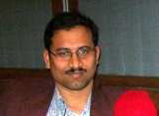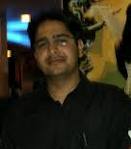Keynotes
|
| |
|
IEEE Distinguished Lecture Ryerson University, Toronto, CANADA |
|

|
It is believed that the electric grid is the most complex machine ever made in human history. This power grid is currently facing many challenges that it has not been originally engineered to handle, especially due to distributed power generation from highly fluctuating renewable sources. The current electric grid technology was established over 50 years ago and it consists of mostly static elements connected to allow unidirectional power flow. It shall allow bidirectional power to accommodate current distributed power generators. The grid is also expected to be smart and adaptive, continuously optimizing the performance with self healing capabilities to cater increased consumer interaction. Various telecommunication technologies are imperative to realize this upcoming smart grid. Since the smart grid is so complex with multiple (core, distribution and access) segments and multitude of applications (from real time fault protection to demand prediction etc), a single communication technology would be inadequate to meet all the requirements. Combination of technologies shall be used. Multiple levels of security and privacy concerns need to be addressed. This talk will provide an overview on various communication technologies and upcoming IEEE standards for the smart grid and discuss different QoS and security requirements. |
|
Dr. Xavier N. Fernando is a Professor and Multimedia Stream Coordinator at Ryerson University, Toronto, Canada. He has PhD from the University of Calgary, Alberta. He has co-authored close to 100 research articles and holds a patent. He is the Chair of the IEEE Toronto Section and an IEEE Communications Society Distinguished Lecturer. He is a member in the IEEE COMSOC Education Board Working Group on Wireless Communications. He has delivered invited talks worldwide including the Cambridge University (UK) and Princeton University (USA). He is a co-author and co-editor of the IEEE Communications Society Wireless Communication Body of Knowledge (WEBOK). He was a visiting scholar at the Institute of Advanced Telecommunications (IAT), UK in 2008. He has worked for AT&T for three years as an R&D Engineer. He is a program evaluator for ABET. His work has won several awards and prizes including IEEE Microwave Society Prize in 2010, Sarnoff Symposium prize in 2009, Opto-Canada best poster prize in 2003 and CCECE best paper prize in 2001. He won IEEE COMSOC Chapter Achievement Award for 2008 and IEEE Toronto Section exemplary service award in 2007. He was the General Chair for IEEE Toronto International Conference on Science and Technology for Humanity 2009. He has obtained funding from Finnish International Development Agency (FINNIDA), Alberta Informatics Circle of Research Excellence (ICORE), Natural Sciences and Engineering Research Council (NSERC) of Canada, Canadian Foundation of Innovations (CFI), Ontario Innovations Trust Fund (OIT), MITACS, and Canadian Photonic Fabrication Research (CPFR). |
|
|
| |
|
|
|

|
Some of the main features of ad-hoc and sensor networks are their dynamic topology, variable and limited resource capacity, constraints of energy and processing power, limited security, the absence of a central server and the ignorance of the nodes that will form the network, which make their self-configuration system a key issue. It has been proved that grouping nodes in a distributed wireless network gives better performance to the group and to the whole system, thereby avoiding unnecessary message forwarding and additional overheads, and thus providing low energy consumption. Grouping nodes also diminishes the average network delay while allows to scale the network considerably. Many wireless ad-hoc and sensor networks have been designed but very few are based on groups. Communications in group-based ad-hoc and sensor networks should be as efficient as possible, hence security issues should not affect to their performance. In this talk we will show the security techniques used in group-based ad-hoc and sensor networks in order to provide reliable communication, privacy, confidentiality, node authentication and authorization, and energy-efficient key exchange mechanisms. We will review the most used systems and we will provide the last research tendencies in this field. |
| Prof. Jaime Lloret received his M.Sc. in Physics in 1997, his M.Sc. in electronic Engineering in 2003 and his Ph.D. in telecommunication engineering (Dr. Ing.) in 2006. He is a Cisco Certified Network Professional Instructor. He worked as a network designer and administrator in several enterprises. He is currently Associate Professor in the Polytechnic University of Valencia. He is the head of the research group "communications and remote sensing" of the Integrated Management Coastal Research Institute and he is the head of the "Active and collaborative techniques and use of technologic resources in the education (EITACURTE)" Innovation Group. He is the director of the University Expert Certificate "Redes y Comunicaciones de Ordenadores", the University Expert Certificate "Tecnologias Web y Comercio Electronico", and the University Master "Digital Post Production". He is currently Vice-chair of the Internet Technical Committee (IEEE Communications Society and Internet society) and the Vice-chair for the Europe/Africa Region of Cognitive Networks Technical Committee (IEEE Communications Society). He has authored 12 books and has more than 220 research papers published in national and international conferences, international journals (most of them with Impact Factor). He has been the co-editor of 15 conference proceedings and guest editor of several international books and journals. He is editor-in-chief of the international journal "Networks Protocols and Algorithms", editor-in-chief of the international Journal "Advances in Network and Communications", IARIA Journals Board Chair (8 Journals) and he is associate editor of several international journals. He has been involved in more than 160 Program committees of international conferences and in many organization and steering committees. He led many national and international projects. He has been the general chair of SENSORCOMM 2007, UBICOMM 2008, ICNS 2009, ICWMC 2010, and eKNOW 2012 and co-chairman of ICAS 2009, INTERNET 2010, MARSS 2011, IEEE MASS 2011, SCPA 2011, and ICDS 2012. He is the co-chairman of IEEE SCPA 2012, GreeNets 2012, IEEE EVN-SGA 2013 and chair of MIC-WCMC 2013. He is IEEE Senior and IARIA Fellow. | |
|
| |
|
|
|

|
Cooperative security subsumes various forms of counteracting selfish behavior of networked devices that, instead of contributing to network-wide goals, pursue their own. Mostly, they manipulate communication protocols, mechanisms, and parameter settings in an attempt to grab a larger-than-fair share of available resources at the cost of other stations that behave cooperatively (honestly), i.e., refrain from any manipulation. Over the last few decades a distinct shift in the network protocol design has been observed in response to the growing need to address cooperative security. The realm of wireless networks is of special interest here, as it is populated by relatively intelligent energy- and bandwidth-hungry stations that at the same time enjoy little or no administrative supervision due to their mobility, anonymity, and autonomy. It is the combination of these qualities that sets the scene for selfish attacks by network stations; existing protocols are vulnerable to them partly because of the free-for-all nature of the radio channel, but mostly because at the time they were designed no selfish behavior was deemed viable. In the talk, classical and cooperative security are discussed with a focus on the difference in the envisaged attacker model, and the need for incentive compatibility is emphasized. It is pointed out that many known measures against selfish attacks can be described in terms of the game-theoretic notions of strategy domination and various types of equilibria, i.e., solution concepts that have supplanted the optimal operating points of the classical engineering paradigm. The most popular and straightforward types of selfish attackers are epitomized and discussed along with the corresponding countermeasures. Novel incentive compatible schemes are presented regarding the well-known backoff attack in an IEEE 802.11 DCF setting, the EDCA Remapping attack in the context of the former IEEE 802.11e standard extension, as well as the forwarding/routing refusal attack in a multihop wireless topology. In the former two cases, station anonymity plays an important role, as it invalidates the majority of previously studied schemes; selfish attacks are foiled by suitable boundedly rational and Bayesian play, respectively. In the last case, a data-centric reputation system may help on condition that one is able to quantitatively assess its effectiveness, i.e., the amount of energy a selfish station has to expend in order to generate enough self-appraisal to become indistinguishable from an honest one. |
| Prof. Jerzy Konorski received his M.Sc. degree in electrical engineering from the Technical University of Gdansk, Poland, and his Ph.D. degree in computer science from the Institute of Computer Science, Polish Academy of Sciences, Warsaw. He is currently Associate Professor at the Department of Computer Communications, Gdansk University of Technology, where he teaches probability, operational research, and computer network theory and architectures, as well as conducts research in computer networking, performance evaluation, information systems, data transmission, and distributed systems. He has worked on several of European and U.S. government projects, and authored over 100 papers published in international journals or conference records. Dr. Konorski was co-editor of the proceedings of IFIP International Conference on Personal Wireless Communications (PWC'2000) and Wireless and Mobile Networking Conference (WMNC'2009), and has served on the TPC for a number of international conferences on wireless networking, including MSWiM, AdHocNow, AICCSA, WMNC, WSN-ADT, and ICDCN. His current work focuses on the application of game theory to medium access control in wireless networks and low-level security architectures for the Future Internet. | |
|
| |
|
|
|

|
|
Accomplished and award-winning IT Security professional with 14 years of experience, expertise in delivering highly effective, audit, and corporate security solutions to support achievement of business goals. Dedicated, technically equipped person with proficiency at contributing to bottom-line company objectives by leveraging technical / business acumen to design and implement secure business processes, applications, and networks globally. Hands-on, motivational team leader who maintains authoritative presence in all areas of security compliance, design, implementation, and infrastructure technical support. Resourceful, proactive, and creative problem-solver with exceptional interpersonal and communication talents.
Selected Achievements
|
|
|
| |
|
|
|

|
|
|
Dr. B. S. Manoj received the Ph.D degree in Computer Science and Engineering from the Indian Institute of Technology, Madras, India, in July 2004. He is a recipient of the Indian Science Congress Association Young Scientist Award for the Year 2003 and the IBM Outstanding PhD Thesis Award for the year 2004. He co-authored the widely taught text book titled Ad Hoc Wireless Networks: Architectures and Protocols (Prentice Hall PTR, New Jersey, May 2004). From 2006-2011, he taught various subjects such as Data networks II, Networked Services, and Principles of Wireless Mesh Networks at University of California San Diego. He published more than a hundred international publications some which won best paper awards at IRISS 2002, IEEE/ACM HiPC 2004, and IEEE CCNC 2008. One of his papers is awarded the Elsevier award for Most Cited paper during the period from 2005-2010. He is a Senior Member of the IEEE, member of the ACM, and Founding Member of the ISCRAM Association. He also serves in the reviewer panel of Elsevier Computer Communications, Elsevier Computer Networks, Elsevier Ad Hoc Networks, IEEE Transactions on Communications, IEEE Transactions on Wireless Communications, IEEE Communication Letters, IEEE Transactions of Networking, and IEEE Transactions on Mobile Computing. He is currently an Associate Professor at the Indian Institute of Space Science and Technology (IIST), Thiruvananthapuram, focusing on computer systems and networks research. |
|
|
| |
|
The University of Winnipeg, CANADA |
|

|
|
| Dr. Pradeep K. Atrey is an Associate Professor at the University of Winnipeg, Canada. He received his Ph.D. in Computer Science from the National University of Singapore. He was a Postdoctoral Researcher at the Multimedia Communications Research Laboratory, University of Ottawa, Canada. His current research interests are in the area of Multimedia Computing with a focus on Multimedia Surveillance and Privacy, Image/Video Security, Social Media, and Web. He has authored/co-authored over 60 research articles at reputed ACM, IEEE, and Springer journals and conferences. Dr. Atrey is on the editorial board of several journals including ACM Trans. on Multimedia Computing, Communications and Applications and ETRI Journal. He has been associated with over 20 international conferences in various roles such as General Chair, Program Chair, Publicity Chair, Web Chair, and TPC Member. Dr. Atrey was a recipient of the ETRI Journal Best Reviewer Award (2009) and the University of Winnipeg Merit Award for Exceptional Performance (2010). He was also recognized as "ICME 2011 - Quality Reviewer". | |
|
| |
|
|
|

|
There are several differences in how hardware and a cryptographic algorithm designer view a system. For a hardware designer: efficient hardware design is essentially a resource allocation problem. The goal is, given the constraints, to find the optimal balance between required silicon area, operation throughput, energy consumption and design time to implement a system. Obviously the algorithm designer is mainly interested in the cryptographic qualities of the system. The difference is subtle: the hardware designer does not fully comprehend the cryptographic qualities, and the algorithm designer is not able set the constraints for the system. So to have the best design we have to find a correlation between these hardware and software design metrics, which seems to be complex job. In the domain of embedded systems, where we have a scarcity of resources and often a need of real-time response, execution of complex crypto-algorithms require special design efforts. Embracing parallelism with modern multi-core based implementations can allow better performance. This talk will discuss the key design challenges as well as the needed design strategies in building efficient crypto-hardware for embedded system applications, with a special emphasis on FPGA based multi-core architectures. |
| Dr. Amlan Chakrabarti is presently a Visiting Research Associate in the Dept. of Electrical Engineering, Princeton University, New Jersey, U.S.A., he also holds a permanent position as a Reader in the A.K.Choudhury School and of Information Technology, University of Calcutta, India. He is an M.Tech. and Ph.D (Tech.) from the University of Calcutta, India, and has around 10 years of experience combining his industrial, research and academic activities. Prior to joining academics he was an electronic design and automation engineer in Orcad Inc., and he has also served IIIT Kolkata and West Bengal University of Technology as faculty member, prior to his present assignment in the University of Calcutta. He has been the recipient of prestigious BOYSCAST award from the Department of Science and Technology, Govt. of India, in the year 2011, for his contribution to engineering research. He has obtained travel and research fellowships from the premier intuitions and organizations like Princeton University, USA (2011-2012) and Buffalo State University at New York, USA (2007), DST Govt. of India (2010) and University of Calcutta (2007). He is a member of the International Collaboration of CBM-FAIR project led by GSI Helmholtz laboratory, Germany in the projects related to embedded hardware design. He was also invited as the workshop leader in the Digital Design track, in the popular industrial workshop NEPCON 2008, Penang Malaysia. He is a reviewer of IEEE Transactions on Computers and Elsevier Simulation Modeling and Practice Theory. He is a senior member of IEEE, Fellow of ACEE, Sr. Member of IACSIT, Singapore and Life Member of CSI, India. He has been the program committee member of a number of international conferences and some of the recent ones are VDAT 2012, EAIT 2012, CISIM 2011, VLSI 2011, EAIT 2011, ReTIS 2011, ICDCN 2010. He has around 45 publications in international journals and conference proceedings and has presented around 30 tutorial lectures in international and national venues. His present research interests are Quantum Computing, Embedded System Design, VLSI design, and Video & Image Processing. | |
|
| |
|
|
|

|
Today's cyberspace demand quick and accurate information accessible to professionals who are safeguarding the digital resources from malicious attacks and perpetrators. This level of information access decides how efficiently and effective the security team can respond to security incidents and events. Also, we should realize the fact that these information bits are scattered across the network in the form of log entries, triggers and alerts. This is where the concept of Security Operations Center (SOC) comes into picture. The workshop looks into the various aspects of Security Operations Center and covers related topics, technologies and concepts. An extensive coverage of SIEM (Security Information and Event Management) is included as part of the workshop, which is considered to be the core concept behind any SOC. The importance and requirement of an SOC cannot be fully visualized without understanding Threat Landscape , Intelligence and Analysis. Relevant and related scenarios and security incidents shall be covered as part of the workshop. Various tools and resources that are considered to be the building blocks of any SOC are also covered. |
| Manu Zacharia is an information security evangelist with more than sixteen years of professional experience. Awarded the prestigious Microsoft Most Valuable Professional - MVP award for 2009 & 2010 in Enterprise Security stream. Also honored with the prestigious Asia Pacific Information Security Leadership Achievements Award for 2010 from ISC2 under Senior Information Security Professional Category. Creator & Chief Architect of Matriux - Security & Penetration Testing Operating System. Founder of Information Security Day Initiatives & c0c0n International Hacking and Information Security Conference, which is held annually. Author of a book titled "Intrusion Alert - An Ethical Hackers Guide to Intrusion Detection Systems". Founder of Information Security Day Initiatives & c0c0n International Hacking and Information Security Conference, which is held annually. Author of a book titled "Intrusion Alert - An Ethical Hackers Guide to Intrusion Detection Systems". Associated with the Centre for Development of Advanced Computing ( C-DAC- the R & D institution and scientific society of the Ministry of Comn & IT, Gov of India), as a Guest Faculty. | |
|
| |
|
|
|

|
Cloud data centers are home to diverse applications that consist of abundant workflows in the same network, some of which require minimal latency while others require consistently high throughput. In this data center environment, todays state-of-the-art TCP protocol falls short. Recently, a lot of research work has focused on improving the performance of TCP, especially attempting to eliminate the queue build-up and incast problems in data center networks. Data Center TCP (DCTCP) has been considered as one of the most viable solutions. This tutorial focuses on studying the drawbacks of TCP in data center networks and analyzing the behavior of DCTCP in eliminating these drawbacks. It also contains a case study in which we compare the performance of TCP and DCTCP in Data Center Networks. Moreover, the results of a newly designed DCTCP variant called improved DCTCP (iDCTCP) are also discussed . |
| Mohit P. Tahiliani completed his B.E and M.Tech in Computer Science & Engineering from Visvesvaraya Technological University, Belgaum in the year 2007 and 2009 respectively. He is a Gold Medalist in M.Tech and has won EMC Academic Alliance Best Student - 2008 Award from EMC Corporation. He is a certified EMC Proven Professional. His areas of interest include Computer Networks and Storage Technology. He has published technical papers in 4 National Conferences, 10 International Conferences and 1 Peer Reviewed Journal. He has been a Contributor and Reviewer for International Editions of several textbooks published by Pearson Education. He has also contributed a few open source patches to Network Simulator - 2 which are widely used by the research community. Currently he is pursuing Ph.D at National Institute of Technology Karnataka, Surathkal. His area of research is Optimizing Congestion Avoidance and Congestion Control mechanisms in Wired and Wireless Networks. | |